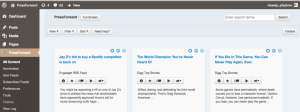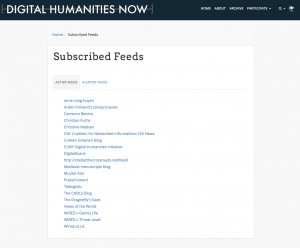For our weekly meetings with Dr. Robertson, the DH fellows each find an interesting new post about digital humanities to share with the group. Over the course of the year, we’re supposed to track some sort of theme or trend. Last year, I focused on posts and projects that work to Indigenize and/or decolonize digital humanities. This year, I’ve followed the ways that the field has responded to criticism from other (non-digital) humanists. At the same time, I’ve been interested in how digital humanists have worked to challenge the rhetoric of tech triumphalists. It strikes me as a problem that even though digital humanists spend so much of their time denouncing technophilia—uncritical enthusiasm for technology—they continue to be accused (en masse) of being technophiles themselves. I am fully onboard with critical DH work, but that work needs to be well-informed to be constructive. It’s unfortunate that the field is still being criticized by apparent techno-cynics who have not bothered to do a basic review of the literature.
With corporations trampling over privacy concerns, ed-tech companies touting ways to replace teachers with machines, and university administrators treating makerspaces as places to push STEM-oriented entrepreneurship over more humanistic endeavors, we need humanists who can engage with data and speak the language of tech more than ever. I have juxtaposed articles that show how exhausting it is to defend the basic premise of digital humanities over and over with articles that show digital humanities is as much about humanizing the digital as it is about doing the humanities digitally. Maybe next year we can stop wasting time addressing the same worn-out, flimsy criticisms and focus our attention where it matters, whether that’s finding ways to decolonize digital archives or pointing out the pernicious realities of the tech world’s utopian promises.
Why Are Non-Data Driven Representations of Data-Driven Research in the Humanities So Bad? by Andrew Piper. In this post, Piper explains that humanists are understandably concerned with “the hegemony of data and data science today,” especially because of the way that the press often treats data-driven arguments as “social certainty.” However, Piper expresses frustration with how people who don’t use data misrepresent data-driven arguments. Because non-data driven arguments are “not subject to the same rules of evidence,” Piper explains, “If you don’t like data, it turns out you can say whatever you want about people who do use data.” It is important that we continue to critique work in the digital humanities, but it’s also important that these critiques are well-informed and based on evidence, not bias.
Twitter’s Response to “The Digital Humanities Bust” by the editors of Digital Humanities Now. A piece in the Chronicle of Higher Education, titled “The Digital-Humanities Bust,” sparked a conversation on Twitter with its claim that the field is all hype and no substance. Because there weren’t yet any blog-length posts, the editors of DHNow (myself included) chose to highlight the tweets. I felt like the Twitter format really served its purpose here. Choosing to respond through tweets that mainly linked out to existing articles, blog posts, and digital projects sent the message that there’s really no need to try to defend digital humanities yet again from the usual tired criticisms; the case for digital humanities has already been made, and those who want to challenge it should at least read up on the basics first.
What is (the value of) Digital Humanities (again, again, again, again…sigh) by Katherine D. Harris. This is a longer post responding to “The Digital Humanities Bust,” with particular attention to the comments section. With exasperation, Harris asserts, “The issue here is not one of critique, but instead a demand that Digital Humanists stand up, be counted, and volunteer to be shot. In no way is the Chronicle article an attempt to do anything other than declare the death of Digital Humanities, or perhaps it’s the author’s wish fulfillment.”
The Disappearance of Books Threatens to Erode Fine Arts Libraries by Sarah Emily Bond. Bond discusses the decision by a dean at the University of Texas at Austin to relocate books and other materials from the Fine Arts Library to off-site storage to create room for a makerspace called The Foundry. According to Bond, The Foundry is the first step in the plan for a new School of Design and Creative Technologies. The dean discussed this plan at the 2018 SXSW Interactive Conference, “suggesting that ‘fine’ arts is an anachronism and should yield primacy to more entrepreneurial, STEM-oriented creative arts such as video game design.” By disconnecting the fine arts from its history, the removal of books represents not just an attack on print resources but the discipline itself. As she explains, “removing books, special collections, and other primary materials from a library space often removes essential sources of inspiration from students’ immediate view.” Bond emphasizes that makerspaces are not panaceas but argues that we need libraries where the digital and the analog coexist, a point she reiterates in a follow-up post on her blog.
Lies, Damned Lies, and Statistics: Some Thoughts from ASU+GSV by Audrey Watters. In this post, Watters reports on some of the “inaccuracies and misinformation” she heard at ASU+GSV, an ed-tech summit. Highlights include that she “heard someone claim that kids learn everything from YouTube these days so they don’t need what’s taught in school” and “heard three different people repeat that old Arthur C. Clarke adage that ‘any teacher who can be replaced by a machine should be.’” Watters says she wanted to scream at the entrepreneurs and investors spreading these lies, but she also “wanted to scream at all those reporters and all those pundits who uncritically repeat these stories too and at all those educators who readily take it all in.”
One Best of All Possible Learning Conferences by Nathan Loewen. This write-up on the 2017 HASTAC conference couldn’t stand in starker contrast to Watters’ experience at ASU+GSV. The theme of the conference was “The Possible Worlds of Digital Humanities,” but, demonstrating that digital humanists are far from technophiles, Loewen finds that, “the events at HASTAC repeatedly demonstrated how applications of humanist skepticism to technology may promote excellence in digital teaching, learning and scholarship.” Loewen describes a focus on “collaboration and openness,” not on uncritical use of digital tools. “Instead, the very structures of digital tools should be interrogated for their implicit biases.”
Can We Do Better Than a 10 Year Gap in Knowledge (re: digital privacy, ethics, etc)? by Jacqueline Wernimont. Mainly in response to the recent Facebook-Cambridge Analytica data scandal, Wernimont expresses her frustration with “the enormous time gap between scholarly understanding of the privacy issues in digital media technology here in the U.S. and public and political awareness.” She explains that she is “flummoxed” that smart people are just now understanding the profiling practices of Facebook (but still don’t seem to realize it’s more than just Facebook) despite the work of academics like herself to draw attention to data monetization, privacy issues, and “the incredible risks that some people face just in engaging online.” Wernimont has more questions than answers in this post. She asks, “Anyone have ideas about how we can make sure that we don’t have another 10 year gap in knowledge?”
Teaching Underrepresented Students How to Navigate Higher Ed Via Digital Humanities by Elizabeth Losh, featuring an email interview with Marisa Parham. With so much (understandable) vexation in this list, I end with a post that speaks to the possibility for digital humanities to redirect our society’s currently misguided STEM obsession and make a better, more just digital (and non-digital) world. Parham explains how K-12 educators can use digital humanities to serve the needs of underrepresented students, including to help them learn to be both digital creators and better digital consumers. Instead of calling for more STEM instruction, Parham makes the case for better STEM that is more fully connected to the humanistic and social scientific. As Parham’s interview makes clear, digital literacy is crucial (especially for underrepresented students), and computational/quantitative/digital humanities should be a part of how students develop digital literacy.


